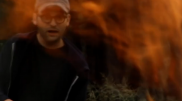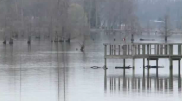Upper Big Branch Mine Disaster: A Brief History
On April 5, 2010, an explosion took place at Massey Energy Co.'s Upper Big Branch Mine in Raleigh County, W. Va. The mine was operated by Performance Coal Company, a Massey Energy subsidiary.
Mine rescue procedures began immediately. Although 25 bodies were recovered in the first hours, the rescue workers had unknowingly walked past the bodies of four missing men for four days because of the amount of smoke, debris and ash.
In total, 29 miners were killed, making it the worst coal accident in the U.S. since 1970. Notably, it marked West Virginia's third major mining disaster in the past four years.
Almost immediately after the disaster, reports of lax safety standards and hundreds of safety violations from the Upper Big Branch Mine surfaced. But federal mining officials maintained that they weren't substantial enough to close the coal mine down.
President Obama condemned the energy company's owners in a statement, saying that the accident was "a failure first and foremost of management."
Many of the violations had to do with inadequate ventilation, which proved to hinder investigation efforts. Because of toxic gas trapped inside the coal mine, investigators couldn't enter it for two months.
Meanwhile, Massey officials claimed that there was "no evidence" of dangerous conditions at the mine, saying that their safety checks did not signal any ventilation problems or methane buildup. However, state and federal records show a history of disputes between government inspectors and Massey about those very issues.
Officials, scientists, and media speculated widely on what caused the explosion. An NPR report revealed that possible tampering of safety monitors may have contributed to the disaster. Others believed that ventilation issues and methane buildup were to blame.
Meanwhile, even though multiple investigations were being conducted at Massey's coal mines, Massey Energy was presented with a safety award on May 28, recognizing "outstanding safety performance" at nine of its other operations.
By September, the federal Mine Safety and Health Administration's investigation determined coal dust to be a major factor in the mine's explosion. This was hotly contested by Massey, calling the MSHA "narrow-minded" and "more interested in proving itself right, even if the evidence suggests the agency's presumptions are wrong".
According to a WCHS interview with Massey CEO Don Blankenship in November, a crack had developed in the mining wall adjacent to a digging machine, releasing an unprecedented amount of natural gas into the area where coal mining was taking place. The air flow in the tunnel was directing the gas away from safety sensors, meaning that they could not accurately monitor the air quality. Eventually, sparks and embers caused by the digging machine ignited the mine's fateful explosion.
In November, the MSHA threatened to seize the mine in order to conduct a test of the mine's dust suppressing spray system, accusing Massey of impeding investigation efforts. However, Massey officials said they couldn't submit to the MSHA's requests as they weren't done with their own investigation. Tensions eased as the year drew to a close, and an extension was granted for Massey to keep studying its own mine.
At the end of 2010, Blankenship stepped down. Some speculated that he was forced into retirement, as the announcement was made by Massey's board of directors, not Blankenship himself.
Blankenship's payout includes a free house for the rest of his life, $2.7 million on retirement, and a monthly "salary continuation retirement benefit" of $18,241.
According to NPR, some of Massey's water-based safety mechanisms were not working properly before the disaster. Some researchers suggested that this could have helped prevent the disaster.
On Jan. 19, 2011 the MSHA met with families affected by the disaster to discuss the organization's first theory on what caused the explosion: a methane leak ignited and due to worn longwall bits -- coal dust -- lingering in the air. Due to faulty water spraying systems, the fire spread throughout the mine.
At the end of January, Massey again countered the MSHA's conclusion with its own preliminary assessment and meeting. Officials claimed their study of the gas in he air -- 90 percent methane and 6 percent ethane -- matches the composition of natural gas rather than what coalbed methane would put into the air of the mine, meaning an unexpected "natural disaster" occured rather than an accident due to negligence.
The Governor's Independent Investigation Panel released an independent report on the disaster on May 19, 2011. It placed the blame not only on failed safety mechanisms (similar to the theory developed by the MSHA), but also on Massey's mismanagement and lack of federal oversight. The coal company has since rejected the assessment, as its investigation remains unfinished.
By May 2011, seven families have accepted the settlement amount Massey first offered in the weeks following the disaster. However, some families have opted to file wrongful death suits against the coal company.





